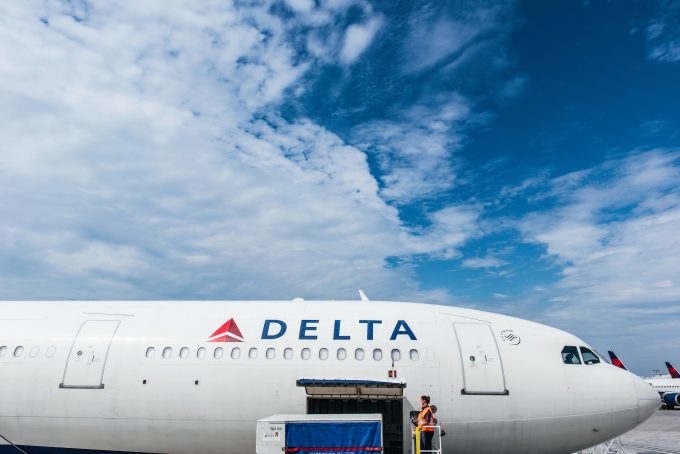US mega-airlines grow cargo volumes, but miss out on ecommerce boom
The three US mega-airlines – Delta, United and American – expanded their cargo traffic in ...
TFII: SOLID AS USUALMAERSK: WEAKENINGF: FALLING OFF A CLIFFAAPL: 'BOTTLENECK IN MAINLAND CHINA'AAPL: CHINA TRENDSDHL: GROWTH CAPEXR: ANOTHER SOLID DELIVERYMFT: HERE COMES THE FALLDSV: LOOK AT SCHENKER PERFORMANCEUPS: A WAVE OF DOWNGRADES DSV: BARGAIN BINKNX: EARNINGS OUTODFL: RISING AND FALLING AND THEN RISING
TFII: SOLID AS USUALMAERSK: WEAKENINGF: FALLING OFF A CLIFFAAPL: 'BOTTLENECK IN MAINLAND CHINA'AAPL: CHINA TRENDSDHL: GROWTH CAPEXR: ANOTHER SOLID DELIVERYMFT: HERE COMES THE FALLDSV: LOOK AT SCHENKER PERFORMANCEUPS: A WAVE OF DOWNGRADES DSV: BARGAIN BINKNX: EARNINGS OUTODFL: RISING AND FALLING AND THEN RISING

Air freight customers will soon be able to track shipments from warehouse to destination using bluetooth technology.
The race to implement bluetooth in unit load devices (ULDs) has seen Delta Cargo and Cathay Pacific take the lead, and this morning Delta said its real-time tracking could now be extended beyond the airport into customer facilities, and would be ready to launch in January.
Not only will the technology help track cargo, but it will also eliminate all paperwork at the dock door when ULDs are loaned out.
A digital uniform control receipt will be emailed directly to the shipper and customers will receive customised push notifications, with full tracking available.
Delta has partnered with ACL Airshop, which offers ULD repairs and leasing at 40 top cargo hubs, and CORE Technologies.
Steve Townes, CEO of ACL Airshop, said: “CORE’s patented bluetooth applications for the air cargo industry are a game changer for airlines and their shipper customers.
“Now implementing with a number of forward-thinking airlines … this latest technology upgrade from CORE can yield new competitive advantages and logistics efficiencies for airlines.”
Since March, Delta has deployed bluetooth tracking technology at 80 airline warehouse locations and has 70 more to go. Almost 40% of its ULD fleet is tagged with bluetooth asset trackers and Delta said the information would help it “monitor and reroute shipments that are delayed due to irregular operations, like inclement weather”.
Shawn Cole, Delta’s vice president-cargo, added: “The extension of the tracking technology directly to our customers’ facilities will ensure visibility for the whole freight journey. This is a genuine innovation.”
Cathay Pacific is also close to delivering end-to-end visibility in its cargo shipments following successful trials of bluetooth tracking with ULD partner Unilode.
Unilode not only used a low-energy version, which it also claims has superior performance and range, but also was able show the data capture on smart phones and tablets.
The ULD lessor said it would roll out the “digital enablement” of its ULD fleet, allowing other airlines to benefit from the technology.
Cathay’s tracking trials are also using blockchain to capture the ULD’s unique number and the agent it is released to, creating a timeline for the custody of each unit. It can then be monitored with the bluetooth tracking.
“Most of the cargo supplied to us in Hong Kong is pre-packed,’ said general manager, cargo service delivery, Frosti Lau. “That means we release empty ULDs to cargo agents and they build up the cargo at their warehouse and then submit the cargo as a pre-packed unit to us.
“So you can imagine this loan process requires a lot of ULD movements, and a lot of ULDs are with agents at any given time.”
The technology reduces the number of “idling” ULDs, which can be traced and made available for shipments.
But customer warehouses needed more trials than the airline’s airport facilities.
“Our cargo terminal is a different environment to many of the warehouses to where we deliver cargo at outports,” said Calvin Hui, eCargo and digital enablement manager.
“While the terminal is a complex, multi-storey facility, most outport warehouses will be single-storey and densely packed with cargo. We needed to make sure the technology works in this sort of environment too.”
It successfully tested the technology in a warehouse in Melbourne.
Comment on this article